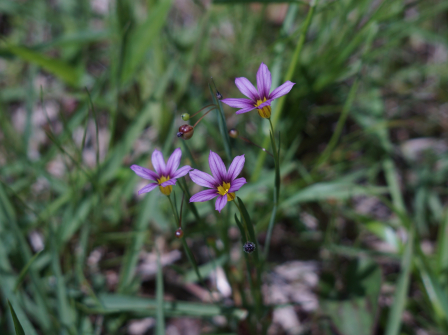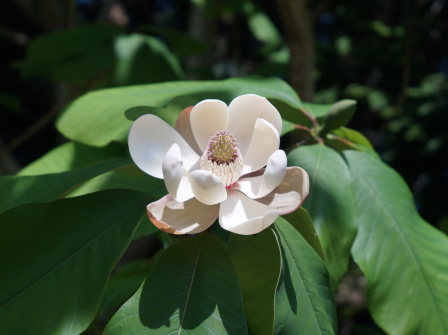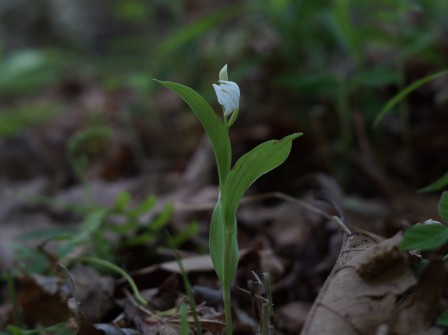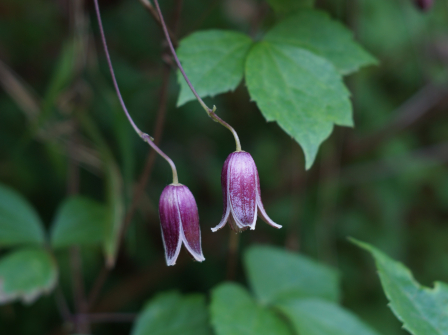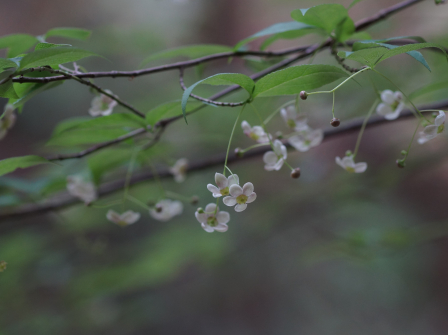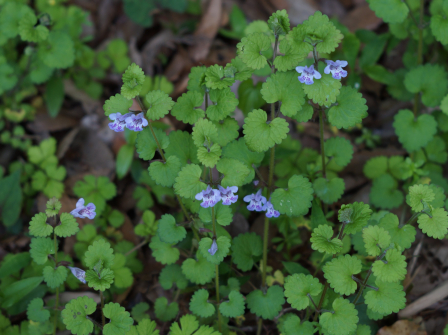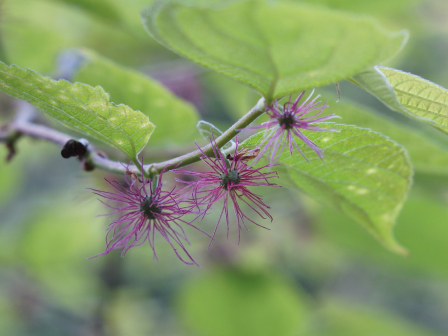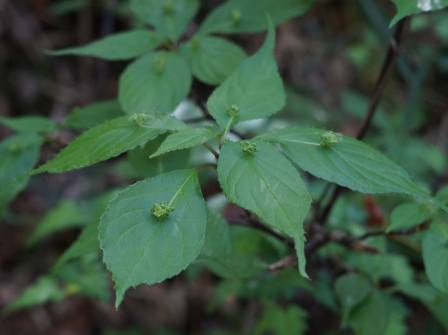フィールド日記
2023.05.19
ニワゼキショウ
ニワゼキショウが咲いています。北アメリカ原産の帰化植物で、日当たりのよい芝地などによく見られます。花のあとには球形の果実ができます。和名は、セキショウという植物に葉のつき方が似ていて、庭に生えることに由来します。
"Niwa-Zekishou (ニワゼキショウ)" plants are in bloom. They originally come from North America and often grow in sunny grasslands. After flowering, they bear round fruits. The name comes from the fact that they grow in gardens and that the way their leaves are attached look like the plants called "Sekishou (セキショウ)".
2023.05.16
ホオノキ
ホオノキの花が咲いています。15cmほどの大きな花が咲く落葉高木です。写真の花は開き始めであまり目立ちませんが、雄しべの花糸(葯を支える柄の部分)は赤味を帯びています。葉がたいへん大きいのも特徴で、30cmほどもあり、古くから食べ物を包んだり、盛ったりするのに使われてきました。
"Hoo-No-Ki (ホオノキ)" trees are in bloom. They are deciduous tall trees blooming 15cm large flowers. Their filaments are red, which we hardly see in the photo because the flower is just starting to open. One of their characteristics is their large leaves, which are about 30 cm in length and have been used for wrapping and serving food since a long time ago.
2023.05.12
ギンラン
ギンランが咲いています。野生の蘭の一種で、林内や林縁に見られます。ギンランは地下で菌根菌と共生しており、また、菌根菌はクヌギなどの樹木と共生しているため、ギンランの生育環境は三者の共生関係によって成り立っています。しかし、生育環境の減少や園芸目的の採取によって数を減らしており、多くの自治体で絶滅が危惧されています。
2023.05.09
ハンショウヅル
ハンショウヅルが咲いています。林縁に見られるつる植物です。和名は、花の形が小型の釣鐘である半鐘(はんしょう)に似ていることに由来します。学名はClematis japonicaで日本のクレマチスを意味します。
"Hanshou-Zuru (ハンショウヅル)" plants are in bloom. They are a vine plant that grows on the edge of forests. The Japanese name comes from the fact that their flowers look like "Hanshou (ハンショウ)", which means a small hanging bell. Its scientific name "Clematis japonica" means Japanese clematis.
2023.05.05
ツリバナ
ツリバナが咲いています。山地に普通に見られる落葉低木です。名前の通り、花は枝から吊り下がって咲きます。秋には鮮やかな赤い実をつけて、よく目立ちます。
2023.05.02
カキドオシ
カキドオシが咲いています。湿った道端や林縁に生えるシソ科の多年草で、葉をもむと良い匂いがします。和名は垣通し(かきどおし)の意味で、花の後につるを伸ばし、垣根を越えて広がっていくようすに由来します。
2023.04.28
ヒメコウゾ
ヒメコウゾの花が咲いています。一見、花には見えないユニークな形をしていますが、写真の赤い毛の生えた球体は雌花の集まりで、赤い毛の一本一本が雌しべです。ヒメコウゾは雌雄同株で、雄花の集まりも同じ木に見られますが、この写真には写っていません。林縁に見られる落葉低木で、樹皮は和紙の原料として使われていました。
"Hime-kouzo (ヒメコウゾ)" trees are in bloom. They might not be recognized as flowers at a glance. The spheres with red hair in the photo are the clusters of their flowers and every single red hair is their pistil. "Hime-kouzo" are monoecious, so each tree has both male and female flowers. However, we can’t see male flowers in the photo here. They are deciduous shrubs that are often seen in the edge of forests. Their barks were used for making Japanese paper.
2023.04.25
ホウチャクソウ
ホウチャクソウが咲いています。林内に普通に見られる多年草で、不二聖心では校舎裏に群生しています。花は下向きに咲き、釣り鐘のような形をしています。この形が、寺院などに吊り下げられる宝鐸(ほうちゃく)という飾りに似ていることが、和名の由来です。
"Houchaku-Sou (ホウチャクソウ)" plants are in bloom. They are common perennial plants that grow in woods. They grow in clusters behind the school building on campus. Their flowers bloom downward and look like hanging bells. Their name comes from the fact that the shape of their flowers looks like a "Houchaku (宝鐸)", which is an ornament hanging on temples.
2023.04.21
シャガ
シャガが咲いています。人里に近い林に生える多年草で、もともとは中国から渡来したと言われています。花は一日花で、朝開いて夕方にはしぼみます。花は咲くものの種子はできないため、地下茎が伸びて広がるか、人によって運ばれて分布を広げていると考えられます。
2023.04.18
ハナイカダ
ハナイカダが咲いています。山地に見られる落葉低木で、葉の真ん中に花をつけるというユニークな特徴をもっています。雌花だけをつける木と雄花だけをつける木にわかれている雌雄異株です。雌花はふつう1つだけつき、雄花は数個つきます。写真は雄花です。
"Hana-Ikada (ハナイカダ)" trees are in bloom. They are deciduous shrubs that grow in mountains. They have a unique characteristic that their flowers bloom in the center of their leaves. "Hana-Ikada" trees are dioecious. Some trees bloom only female flowers and the others bloom only male flowers. The female trees normally have one female flower on a leaf and the male trees have a few male flowers on a leaf. The flowers in the photo are male flowers.


